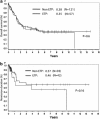Clinical and molecular characterization of early T-cell precursor leukemia: a high-risk subgroup in adult T-ALL with a high frequency of FLT3 mutations
- PMID: 22829239
- PMCID: PMC3270253
- DOI: 10.1038/bcj.2011.49
Clinical and molecular characterization of early T-cell precursor leukemia: a high-risk subgroup in adult T-ALL with a high frequency of FLT3 mutations
Abstract
A subgroup of pediatric acute T-lymphoblastic leukemia (T-ALL) was characterized by a gene expression profile comparable to that of early T-cell precursors (ETPs) with a highly unfavorable outcome. We have investigated clinical and molecular characteristics of the ETP-ALL subgroup in adult T-ALL. As ETP-ALL represents a subgroup of early T-ALL we particularly focused on this cohort and identified 178 adult patients enrolled in the German Acute Lymphoblastic Leukemia Multicenter studies (05/93-07/03). Of these, 32% (57/178) were classified as ETP-ALL based on their characteristic immunophenotype. The outcome of adults with ETP-ALL was poor with an overall survival of only 35% at 10 years, comparable to the inferior outcome of early T-ALL with 38%. The molecular characterization of adult ETP-ALL revealed distinct alterations with overexpression of stem cell-related genes (BAALC, IGFBP7, MN1, WT1). Interestingly, we found a low rate of NOTCH1 mutations and no FBXW7 mutations in adult ETP-ALL. In contrast, FLT3 mutations, rare in the overall cohort of T-ALL, were very frequent and nearly exclusively found in ETP-ALL characterized by a specific immunophenotype. These molecular characteristics provide biologic insights and implications with respect to innovative treatment strategies (for example, tyrosine kinase inhibitors) for this high-risk subgroup of adult ETP-ALL.
Figures



References
-
- Tremblay CS, Hoang T, Hoang T. Early T cell differentiation lessons from T-cell acute lymphoblastic leukemia. Prog Mol Biol Transl Sci. 2010;92:121–156. - PubMed
-
- Bell JJ, Bhandoola A. The earliest thymic progenitors for T cells possess myeloid lineage potential. Nature. 2008;452:764–767. - PubMed
-
- Meijerink JP. Genetic rearrangements in relation to immunophenotype and outcome in T-cell acute lymphoblastic leukaemia. Best Pract Res Clin Haematol. 2010;23:307–318. - PubMed
LinkOut - more resources
Full Text Sources
Other Literature Sources
Research Materials
Miscellaneous

